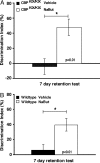Modulation of long-term memory for object recognition via HDAC inhibition
- PMID: 19470462
- PMCID: PMC2695069
- DOI: 10.1073/pnas.0903964106
Modulation of long-term memory for object recognition via HDAC inhibition
Abstract
Histone acetylation is a chromatin modification critically involved in gene regulation during many neural processes. The enzymes that regulate levels of histone acetylation are histone acetyltransferases (HATs), which activate gene expression and histone deacetylases (HDACs), that repress gene expression. Acetylation together with other histone and DNA modifications regulate transcription profiles for specific cellular functions. Our previous research has demonstrated a pivotal role for cyclicAMP response element binding protein (CREB)-binding protein (CBP), a histone acetyltransferase, in long-term memory for novel object recognition (NOR). In fact, every genetically modifiedCbp mutant mouse characterized thus far exhibits impaired long-term memory for NOR. These results suggest that long-term memory for NOR is especially sensitive to alterations in CBP activity. Thus, in the current study, we examined the role of HDACs in memory for NOR. We found that inducing a histone hyperacetylated state via HDAC inhibition transforms a learning event that would not normally result in long-term memory into an event that is now remembered long-term. We have also found that HDAC inhibition generates a type of long-term memory that persists beyond a point at which normal memory for NOR fails. This result is particularly interesting because one alluring aspect of examining the role of chromatin modifications in modulating transcription required for long-term memory processes is that these modifications may provide potentially stable epigenetic markers in the service of activating and/or maintaining transcriptional processes.
Conflict of interest statement
The authors declare no conflict of interest.
Figures




References
Publication types
MeSH terms
Substances
Grants and funding
LinkOut - more resources
Full Text Sources
Other Literature Sources
Medical
Molecular Biology Databases

